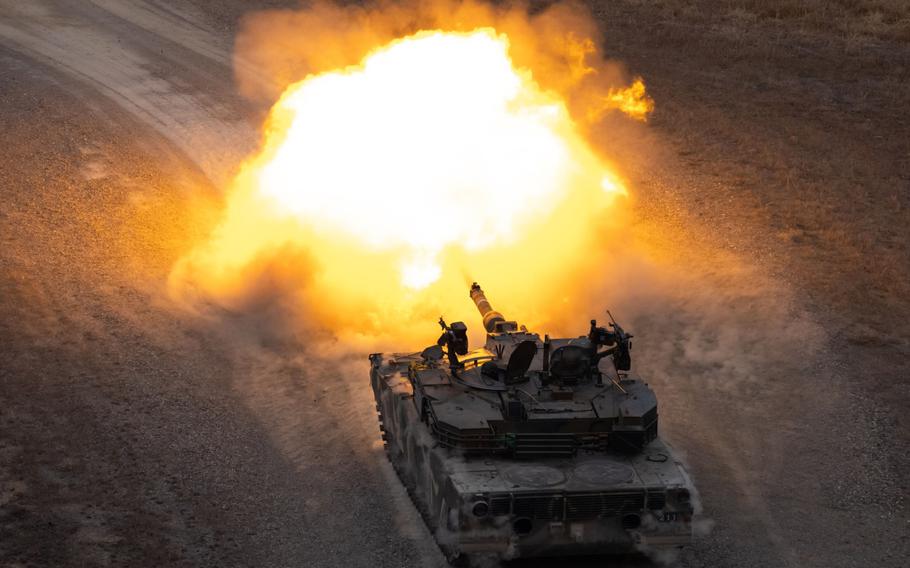
A South Korean army K1A1 tank, manufactured by Hyundai Rotem Co., fires during a joint live-fire exercise with the U.S. Army at Rodriguez Range in Pocheon, South Korea, on Wednesday, March 22, 2023. (SeongJoon Cho/Bloomberg)
Half a world away from the front line of Russia's war in Ukraine there's a stockpile of probably more than a million artillery shells on the Korean Peninsula — a hoard that's drawing attention as South Korea's leader heads to Washington.
President Yoon Suk Yeol has indicated his government may be open to changing its policy about providing lethal aid to Ukraine under certain conditions. That would be welcome news for President Joe Biden, who has been seeking help from partners to ease Kyiv's perennial ammunition shortage.
Yoon's office said any decision to send lethal aid depends on how far Russia goes in stepping up attacks on civilians. Yoon is due to meet Biden for a state visit on Wednesday, with security and economic cooperation high on the agenda.
One factor weighing on Yoon will be whether a decision by Seoul to move closer to Kyiv in the conflict would be met by Russian President Vladimir Putin increasing military cooperation with North Korea, said Soo Kim, a former Korea analyst at the U.S. Central Intelligence Agency, who now works at U.S.-based management consulting firm LMI.
The Kremlin has said that if South Korea supplies arms to Ukraine it would make it a participant in the conflict, with former Russian president Dmitry Medvedev suggesting Moscow could respond by selling advanced weaponry to North Korea, according to a Tass report.
"The question is whether Yoon takes Putin's threat seriously, and whether he thinks a Russian retaliation would be as consequential as Putin makes it out to be," Kim said.
Ukrainian President Volodymyr Zelenskyy has long sought weapons from South Korea and even made a personal appeal for the aid when he spoke to the South Korean parliament in April last year.
The Koreas have two of the world's largest artillery forces, with thousands of big guns pointing at each other across the demilitarized zone that separates them. They have stockpiled hundreds of thousands of shells that include North Korean artillery interoperable with Soviet-era artillery in Russia, and South Korean 155 mm caliber shells, which are the standard used by the NATO countries supplying Ukraine.
South Korean Defense Ministry officials would not comment on the number of munitions it has in stock for security reasons and North Korea does not release that sort of information to the outside world.
“You can bet the stocks of both North and South easily exceed a million shells of differing types,” said Joost Oliemans, a weapons expert who co-authored the book “The Armed Forces of North Korea.” “Both operate many thousands of artillery pieces, which, even without being restocked, would necessitate hundreds of thousands of shells,” he said.
The New York Times reported that leaked intelligence documents posted on social last month showed Seoul was also looking at selling 330,000 rounds of 155 mm artillery shells to Poland. The paper said the documents showed a debate within the Yoon government between bowing to U.S. pressure to help supply Ukraine and the nation's official policy of not providing weapons to countries at war.
South Korea's DongA Ilbo newspaper reported earlier this month that the Yoon administration could lease about 500,000 155 mm shells to the U.S., which could be used to indirectly supply Ukraine. Yoon's government played down the reports, suggesting the documents didn't reveal sensitive information and had parts that were fabricated.
Oliemans said the notion of the U.S. purchasing directly, loaning or acquiring the shells through Poland is "probably the most direct way South Korea could influence Ukraine's long-awaited spring offensive and the war in the near term, barring a sudden willingness to deliver armaments such as advanced air defenses."
Meanwhile, North Korea's huge stockpile of artillery has apparently attracted the attention of Russia.
The U.S. has accused Kim Jong Un's regime of providing arms and ammunition to aid Putin's war, including sending shells and rockets. While the Biden administration said the weapons won't do much to alter the battlefield situation, the sales would open a new stream of revenue to a country isolated from much of world trade.
Some North Korean items likely on Putin's wish list would be 122 mm and 152 mm artillery rounds as well as 122 mm rockets. The government in Pyongyang has denounced the charges as groundless rumors.
While Seoul may not be officially sending arms to Ukraine, Russia's war has opened a door for South Korea's defense exports, which were on track to more than double in 2022 as buyers including countries in Europe seek to replace Soviet-era weaponry with higher tech arms. In December, Poland received 10 K2 tanks and 24 self-propelled K9 howitzers, the first part of an almost $6 billion agreement reached in August with Hyundai Rotem and Hanwha Defense Systems.
Washington seems to be giving the green light to South Korea to sell to states in places like Eastern Europe as U.S. defense contractors race to fill orders for weapons that will go to Kyiv and Taipei, which is facing threats from China.
Yoon left for Washington Monday and is scheduled to meet with Biden on Wednesday. The two leaders are expected to discuss security cooperation on a global level, including potential aid for Ukraine.
Bloomberg's Jeong-Ho Lee and Shinhye Kang contributed to this report.